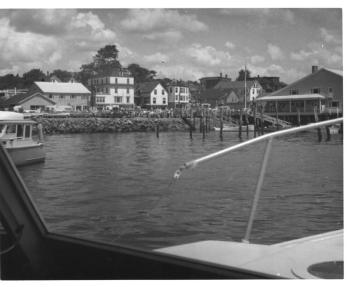Out of our past
Last time, I described early 1900s Boothbay region trash habits in these revised and lengthened 2003 articles. There was little trash, particularly in the first half of the 1900s since women and men usually cooked from scratch. Households used mostly paper products, a few cans, and perhaps some glass jars though many people took their jugs, cloth bags, and jars to buy staples such as molasses and flour, often rowing to Bath for staples.
The local population, traditionally not well-off, did for themselves much more than can be easily comprehended now, in this long age of plenty since World War II. There were few cars before the 1950s, so you shopped as locally as possible for the things you could not make, walking and carrying containers, or pushing a wheelbarrow, or taking a heifer for loads, or hoping for the sound of a car slowing down to offer a ride.
Most people usually had a very small home dump. As the region’s population continually transformed to more tourists, summer people, and retirees, there was more of a call for actual garbage men and trucks. More needs arose with the increasing number of restaurants that mostly served that more well-to-do segment.
Local Dumps
I was told there was a disused dump off the Bradley Road toward East Boothbay. Curious, I asked Jeannine Harrington of the Bayville Road about it. She told me that Johnny Bradley, who served as a garbage man in the mid-1900s, owned much of the land and used part of it as a dump. Toots Adams, in her 80s in the 2000s, remembers that Johnny Bradley got their trash when she and her husband Lewis lived in the Harbor over Jordan's Restaurant on Commercial Street from about 1946 to 1954. There was always a seagull perched on top of Johnny's pickup, waiting for snacks, as Johnny drove around town. Toots also believes that Farley Stone may have been a garbage man. Built-up areas with non-drivers certainly needed someone for such household help.
Trash as a Public Problem
I believe townspeople first focused on trash as a public problem in the 1920s. The booming economy led to well-off newcomers, whether new summer residents or short-term sightseers. The Boothbay Register printed appeals for residents to clean up the streets for the sake of enticing visitors, to have the region become a desirable destination. But it was not town-sponsored, just a wistful request for a show of town pride. In 1930 the Harbor selectmen did instruct the harbor commissioner (head of the small town crew) to clean up along the shore, and announced they'd prosecute anyone found dumping rubbish. So perhaps that marks the beginning of a move away from no rules at all.
Growing Harbor Town Control
But what was the status of the Harbor dumps? Was there town control? At first I believed most were private because, as written above, Johnny Bradley used his own land and clearly the dump mentioned in the prior article near the Gamages was private. However, I found out different with a little town report checking. The first year the Harbor appropriated money for a dump was 1935, paying Perkins & Tupper, who owned much of Fishers Hill, for a dump--so that's the Fishers Hill dump. In 1937 the town paid David Pennington, on the Meadow, for allowing a dump on his property. So those two, at least, were town-sponsored to some extent.
Along that line, summer 1936 Boothbay Registers mention that the Fishers Hill dump was shutting, and that one would open above Farmer's pool at West Harbor on old Elbridge Giles's land--grandfather to the present Elbridge. But there were complaints about its polluting the swimming pool so it shut quickly and Pennington's Meadow dump opened in late summer 1936. In the 1950s there was talk of a dump at one of Bonnie Locke's gravel pits, off the road to East Boothbay, but nothing came of it. Quite possibly there was fear of polluting residents’ water source running through there from Boothbay Center to Lobster Cove, whether the broad waterway or wells.
Next time: the final choice for the dump at the current site of the Boothbay Region Refuse Transfer Station.































.png)
.png)

